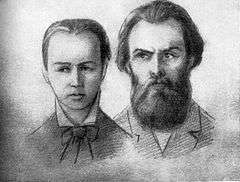Sophia Perovskaya
| Sophia Perovskaya | |
|---|---|
 | |
| Born |
13 September 1853 Saint Petersburg, Russian Empire |
| Died |
15 April 1881 (aged 27) Saint Petersburg, Russian Empire |
Sophia Lvovna Perovskaya (Russian: Со́фья Льво́вна Перо́вская; 13 September [O.S. 1 September] 1853 – 15 April [O.S. 3 April] 1881) was a Russian revolutionary and a member of Narodnaya Volya. She helped orchestrate the successful assassination of Alexander II of Russia, for which she was executed by hanging.
Biography
Perovskaya was born in Saint Petersburg, into an aristocratic family who were the descendants by marriage of Elizabeth of Russia. Her father was the former military governor of Saint Petersburg, and her grandfather had been Minister of the Interior. She spent her early years in the Crimea, where her education was largely neglected, but where she began reading serious books on her own.[1] After the family moved to Saint Petersburg, Perovskaya entered the Alarchinsky University for Women in 1869. Here she became friends with several girls who were interested in the radical movement. She left home at the age of sixteen over her father's objections to her new friends.[1] In 1871–1872, together with these friends, she joined the Circle of Tchaikovsky. In 1872–1873 and 1874–1877, she worked in the provinces of Samara, Tver, and Simbirsk. During this period, she received diplomas as a teacher and a medical assistant.
A prominent fellow member of the Circle of Tchaikovsky, Peter Kropotkin, said the following of Perovskaya:
In her moral conceptions she was a "rigorist", but not in the least of the sermon-preaching type. Perovskaya was a "populist" to the very bottom of her heart, and at the same time a revolutionist, a fighter of the truest steel. She said to me once: "We have begun a great thing. Two generations perhaps, will succumb in the task, and yet it must be done." [1]
In 1873, Perovskaya maintained several conspiracy apartments in Saint Petersburg for secret anti-tsarist propaganda meetings that had not been sanctioned by the authorities. In January 1874, she was arrested and placed in the Petropavlovskaya fortress in connection with the Trial of the 193. In 1877–1878, she was acquitted. Perovskaya also took part in an unsuccessful attempt to free Ippolit Myshkin, a revolutionary and a member of Narodnaya volya. In the summer of 1878, Perovskaya became a member of Zemlya i volya, was soon arrested again, and banished to the Olonetskaya province. She managed to escape on her way to exile and went underground.
As a member of Zemlya i volya, Perovskaya went to Kharkov in order to organize the liberation of political prisoners from the central prison. In the fall of 1879, she became a member of the Executive Committee and later a member of the Administrative Committee of Zemlya i volya. Perovskaya propagandized among students, soldiers, and workers, took part in organizing the Worker's Gazette, and maintained ties with political prisoners in Saint Petersburg. In November, 1879 she took part in an attempt to blow up the Imperial Train on its way from Saint Petersburg to Moscow. The attempt failed. On her return to Saint Petersburg she joined Narodnaya Volya.[1]
Perovskaya participated in preparing assassination attempts on Alexander II of Russia near Moscow (November, 1879), in Odessa (spring of 1880), and Saint Petersburg (the attempt that eventually killed him, 1 March 1881). She was the closest friend and later the wife of Andrei Zhelyabov, a member of the Executive Committee of Narodnaya Volya. Perovskaya was arrested on 10 March 1881 and was the first woman in Russia sentenced to death by hanging for terrorism. Four other Pervomartovtsy were executed with her.[1]
See also

- Women in the Russian Revolution
- YouTube recording of 1967 Soviet film Sophia Perovskaya (Софья Перовская)[2]
In literature
- Henry Parkes was inspired to write the poem, The Beauteous Terrorist. Reproduced in full in The Beauteous Terrorist and Other Poems by Sydney Electronic Text and Image Service.
- Moss, Walter G., Alexander II and His Times: A Narrative History of Russia in the Age of Alexander II, Tolstoy, and Dostoevsky. London: Anthem Press, 2002. Several chapters on Perovskaya. (available online)
- Croft, Lee B. Nikolai Ivanovich Kibalchich: Terrorist Rocket Pioneer. IIHS. 2006. ISBN 978-1-4116-2381-1. Content on Perovskaya, including her father, mother, and her unmarked burial.
References
| Wikimedia Commons has media related to Sophia Lvovna Perovskaya. |